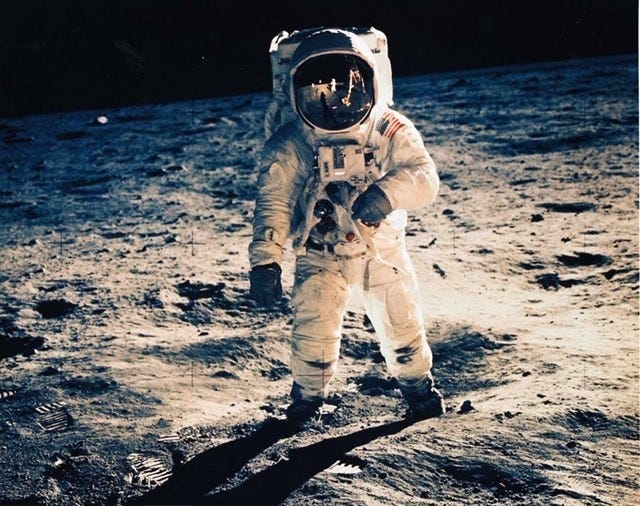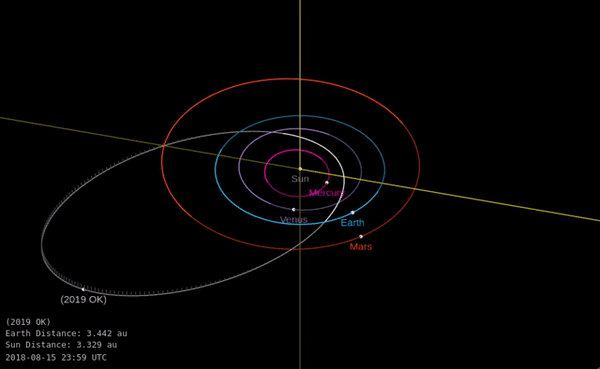Page 8483
Jul 29, 2019
Apollo 11: 50th anniversary of the moon landing
Posted by Genevieve Klien in categories: space, virtual reality
We look back at the historic 1969 moon landing of the Apollo 11. Hear stories from the original crew, explore photos and experience the launch in VR.
Jul 29, 2019
A huge asteroid flew very close to Earth last week. How did we miss it?
Posted by Richard Christophr Saragoza in categories: asteroid/comet impacts, existential risks
The asteroid managed to get within just 73,000 kilometers of our planet without anyone noticing. The miss lends a new sense of urgency to preparations for a potential collision one day.
The news: On Thursday July 25 an asteroid dubbed “Asteroid 2019 OK”, measuring 57 to 130 meters wide (187 to 427 feet), got uncomfortably close to Earth, according to NASA’s near-Earth objects database. It was less than one-fifth of the distance to the moon away, making it a very close call in space terms. If it had landed on a populated area it could have caused major damage, although this outcome is statistically quite unlikely.
Should we worry? It’s hard not to feel concerned that a “city-killer” sized asteroid wasn’t detected further ahead of time. It was announced just hours before it passed by Earth, after being detected just a few days beforehand by teams in the US and Brazil. Its relatively small size, unusual orbit, and fast speed all conspired to make it tough to spot, researchers told the Washington Post.
Jul 29, 2019
Japan approves first human-animal embryo experiments
Posted by Derick Lee in categories: bioengineering, biotech/medical, genetics
But getting human cells to grow in another species is not easy. Nakauchi and colleagues announced at the 2018 American Association for the Advancement of Science meeting in Austin, Texas that they had put human iPS cells into sheep embryos that had been engineered not to produce a pancreas. But the hybrid embryos, grown for 28 days, contained very few human cells, and nothing resembling organs. This is probably because of the genetic distance between humans and sheep, says Nakauchi.
The research could eventually lead to new sources of organs for transplant, but ethical and technical hurdles need to be overcome.
Jul 28, 2019
Facebook AI Research Is A Game-Changer
Posted by Genevieve Klien in categories: entertainment, robotics/AI
For decades, computer programmers have been trying to beat multiplayer games by finding reliable patterns in data.
Researchers at Facebook and Carnegie Mellon University published a whitepaper in Science Journal in July that flips this switch. Their software embraces randomness, and it is reliably beating humans at games.
Jul 28, 2019
NASA’s Valkyrie robot could help build Mars base
Posted by Genevieve Klien in categories: robotics/AI, space
Jump to media player The semi-autonomous robot is able to use human tools and guide itself across difficult terrain.
Jul 28, 2019
Neuroscientists reveal the number one exercise for slowing down the aging process
Posted by Paul Battista in category: life extension

At a certain point in our lives all of us develop a negative relationship with the mirror on the wall. It just keeps showing too many lines, too many grey hairs and sagging stuff everywhere.
I know quite a few people who end up refusing to face the mirror for any reason whatever!
Jul 28, 2019
‘Limitless Potential’ of Artificial Protein Ushers in New Era of ‘Smart’ Cell Therapies
Posted by Paul Battista in categories: bioengineering, biotech/medical, robotics/AI
Medicine has a “Goldilocks” problem. Many therapies are safe and effective only when administered at just the right time and in very precise doses – when given too early or too late, in too large or too small an amount, medicines can be ineffective or even harmful. But in many situations, doctors have no way of knowing when or how much to dispense.
Now, a team of bioengineers led by UC San Francisco’s Hana El-Samad, PhD, and the University of Washington’s David Baker, PhD, have devised a remarkable solution to this problem – “smart” cells that behave like tiny autonomous robots which, in the future, may be used to detect damage and disease, and deliver help at just the right time and in just the right amount.
Jul 28, 2019
The gut microbiota influences skeletal muscle mass and function in mice
Posted by Paul Battista in categories: biotech/medical, health
Skeletal muscle is important not only for locomotion but also for regulating metabolic function. Lahiri et al. studied the interactions between the gut microbiota and skeletal muscle in mice. They identified genes and signaling pathways involved in the regulation of skeletal muscle mass and function that responded to cues from the gut microbiota. Additional biochemical and functional analysis also revealed the influence of the gut microbiota on the function of neuromuscular junctions. These findings open the door to a better understanding of the role of the gut microbiota in the mechanisms underlying loss of muscle mass.
The functional interactions between the gut microbiota and the host are important for host physiology, homeostasis, and sustained health. We compared the skeletal muscle of germ-free mice that lacked a gut microbiota to the skeletal muscle of pathogen-free mice that had a gut microbiota. Compared to pathogen-free mouse skeletal muscle, germ-free mouse skeletal muscle showed atrophy, decreased expression of insulin-like growth factor 1, and reduced transcription of genes associated with skeletal muscle growth and mitochondrial function. Nuclear magnetic resonance spectrometry analysis of skeletal muscle, liver, and serum from germ-free mice revealed multiple changes in the amounts of amino acids, including glycine and alanine, compared to pathogen-free mice. Germ-free mice also showed reduced serum choline, the precursor of acetylcholine, the key neurotransmitter that signals between muscle and nerve at neuromuscular junctions.
Jul 28, 2019
10 insights from my first 5 episodes of The Ageless Starman podcast
Posted by Paul Battista in categories: biotech/medical, business, life extension, robotics/AI
1. The 4 main things happening in Hyperbaric oxygen treatment: 1.- A decrease of inflammation 2.- An increase in the amount of oxygen in circulation and reversing hypoxia. 3.- Stimulate the release of stem cells from the brain along with the bone-derived stem cells. 4.- Kill infection. Why it matters for regenerative and dementia treatment? Listen to Dr. Scott Sherr explaining in detail in http://www.mendelhaim.com/podcast/2. For more information on Dr. Scott’s work go to https://www.hyperbaricmedicalsolutions.com/integrative-hbot/scott-sherr.
2. Raising money for academic research is a hard point, according to all of my guests, but even when we talk about Hyperbaric treatment there is a lack of money and the number of chambers declines in u.s. In Israel by the way, the demand is increasing and it takes a few months waiting in lines to start getting the treatment, this can turn into a big business opportunity in my opinion as to the risk for such research on participants is not as big as other medical research.
3. Longevity investment is a relatively new field and is lack of a method to invest by, the Three criteria that Sergey Young from the Longevity Vision Fund examine before investing in new companies are 1- will the product be affordable to touch millions of people’s lives and not only help the rich. 2- Looking for sectors that enjoy the technological exponential development paste such as AI, early diagnostics, stem cells, warbles, and organ transplants. 3 — Network, if you are a new startup and trying to raise from The Longevity vision fund, question yourself before, Do you have partners that can market your product such as big pharma or health care chain or a big manufacturer, do you collaborate with the best academic institutes in the longevity research. Go listen to the full episode Mission Alpha with Sergey Young on http://www.mendelhaim.com/podcast/3
















